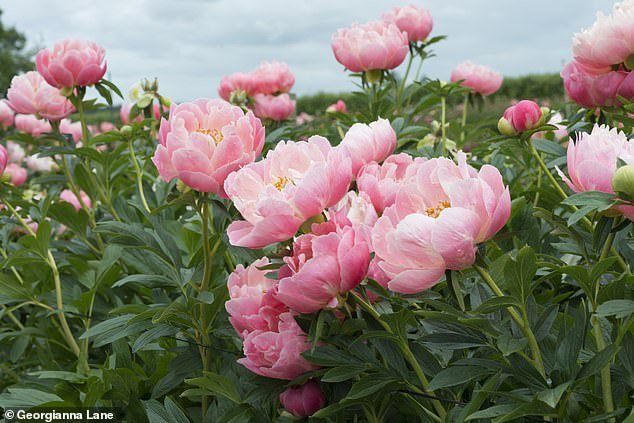Perfect peonies: Make a statement in your garden with these vibrant summer blooms
- Nigel Colborn says peonies have the ability to stand out on any planting scheme
- British gardening expert explains peonies are native to Europe and Asia
- He recommends growing in well-drained soil with plenty of organic matter
Of all garden plants, peonies are the most aristocratic. Their large flowers, handsome foliage and bold stature makes them stand out in any planting scheme. They have a distinguished history, too.
The name comes from Paeon, physician to the gods of ancient Greece. In those days, peony roots were used as a drug to ease childbirth. Today, we grow them mainly for their magnificent flowers.
Peonies are native to Europe and Asia. One, Paeonia mascula grows wild in Britain, but only on Steep Holm and Flat Holm; islands in the Bristol Channel.
Most are herbaceous, dying back in winter. But Chinese ‘tree peonies’ are rather gawky shrubs bearing enormous flowers. Despite their drama, flowering is brief. Herbaceous peonies have more to offer.
aloha: Large Peony lactiflora Pink Hawaiian bears fragrant coral pink flowers
Many develop superb foliage and a few even look good in autumn. Others bring focus to a mixed border with large, often fragrant summer flowers. The finest varieties, developed from Paeonia lactiflora also make excellent cut flowers.
Native to China and Tibet, wild P. lactiflora has copperybacked leaves and tall stems carrying large, single white flowers. The single whiteflowered variety White Wings is closest to its wild forebear.
PRETTY IN PINK
Fancy lactiflora varieties include Pink Hawaiian with fragrant coral blooms and Bowl of Beauty whose pink outer petals surround tufty cream centres.
Double-flowered Sarah Bernhardt is silvery pink, whereas the big double blooms of Adolphe Rousseau are deep, brooding red. Intersectional or Itoh peonies are a more recent introduction. Part tree-peony, part herbaceous, their large flowers come in a wider colour range.
They flower for longer than tree peonies and make lovely specimen plants. Claire Austin’s perennial nursery offers Itoh varieties in yellow, salmon, pink and other hues claireaustinhardyplants.co.uk.
Peonies are not exclusive to summer. My favourite, P. mloko- sewitschii, has primose yellow blooms in early May. The young foliage is copper tinted. There’s also an autumn bonus when the triple-podded fruits resemble medieval jester’s hats.
For spring, Majorcan P. cambessedesii grows a modest 30cm high. Blue-green leaves accompany soft pink, single spring flowers. In autumn, their pods also split to display big, glossy black seeds.
The best-known peonies are double-flowered P. officinalis. Wine-red Rubra Plena or deep pink Rosea Superba Plena.
EASY TO GROW
Peonies prefer well-drained soil with plenty of organic matter. Most need sun but woodland varieties such as Molly the Witch enjoy sun or gentle shade. Lactiflora peonies are best in sun.
Some double-flowered varieties can be top heavy, so support is essential. I use interlocking Link Stakes, but canes and string work just as well.
They need dividing when the clumps grow old and tired. Each new division should carry at least one plump, dormant bud.
Don’t despair if they don’t sprout. Roots develop first, then a shoot appears the following year with flowers in year three – if you’re lucky.
